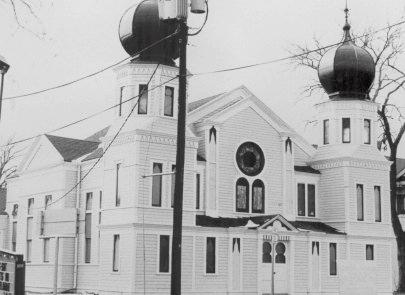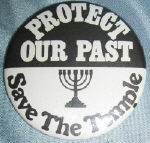Temple Beth-El Courtesy
of the
Supported on brick piers, the two-story Temple is essentially rectangular in plan with a small added wing on the back of the southwest corner. It is covered by two intersecting pitched roofs with gabled ends, although it has a smaller shed roof over the rabbi's study in the front and a barrel roof over a side entrance. The original roof was listed on one Sanborn map as slate, as tin on another, although the feeling is it was apparently wood. The roof is presently clad with composition shingles with clapboard siding on the building. The two onion domes, and the side barrel roof are a painted tin. The front elevation, which faces east, features a classical pediment flanked by matching vertical projections with ogee arches. These ogee arches are repeated around the exterior in windows on all levels and all sides. They give the appearance of a candle which is perhaps a symbol of the "light." The classical pediment sits atop two paneled doors with modified keyhole windows. Pilasters support a continuation of the frieze. On either side of the vertical projections are single pane narrow windows with the ogee arch lying directly beneath identical windows on the recessed second story. In the central section of the second story is large stained glass keyhole window consisting of a circular Star of David atop paired round top tablets. Pilasters with ogee arches are placed directly in line with the lower pilasters flanking the front door. The second- story projections are capped with an abbreviated cornice onto which the pitched roof terminates repeating the allusion of a portico. The actual roofline is recessed a short distance from this faux pediment. The arresting features of this symmetrical facade are the twin three-story towers with their onion domes. Several stages make the transition from the square base to the bulbous domes. The first floor has a centered single pane window with the ogee arch. A water table wraps around the tower and is at the same level as the roof line of the body of the building. Two more ogee arch trim windows are centered on the second floor with a sawtooth cornice element below the water table on the second story roofline. The third story is octagon shaped with a window on each side alternating between keyhole and ogee arch. Another sawtooth molding embellishes the top of the third story. The painted tin onion domes sit above the octagon level. The south elevation is much simpler than the front facade. Broken at midpoint by a one foot projection, the side is two stories with the intersecting pitched roof and end gable atop the projection. This creates the division of the side into thirds, each section housing a pair of double hung one-over-one lights topped by a single pane ogee arch window. It is thought that originally the double hung windows were one-over-one to carry through the motive of the "candle" windows. So nine-over-nine lights possibly installed in the 1950s were recently replaced with the single pane, double hung windows. The west corner of the south elevation has a small one-story extension added in 1954 in keeping with the basic style of the Temple. The west elevation is one-story. It attaches to the second story gable end of the main roof. It has three sets of paired one-over-one double hung windows with no ornamentation. The water table continues around the building at the base of the windows. The north elevation varies from the south in that an entry is located at the base of the tower and a vaulted entry is implemented in the latter half of the recessed portion of the elevation. Both entrys repeat the two paneled door with keyhole windows found on the east elevation. The back one-story wing houses three one-over-one double hung windows. Symmetrical in plan, the interior consists of a vestibule extending across the front of the building with entrances on the east and north sides. The rectangular nave is open to the roof, with a choir balcony in the back or west end. A one-story portion housing the kitchen, bathroom and meeting rooThextends across the entire back of the building and can be separated from the nave by descending pocket doors. The interior is without ornamentation other than the original twenty-four-light brass chandelier. The interior renovation is in its early stages. Temple Beth-El stands as a monument to what was once a thriving and active Jewish community in Corsicana, Texas. It was in that building, erected in 1900, that the Reform congregation worshipped for more than eighty years, keeping alive the Jewish faith in the midst of a fundamentalist, Protestant city. Members of the Temple were highly visible citizens of the community, contributing significantly to the economic development, cultural activities, and civic affairs of Corsicana. They also donated generously to various philanthropic endeavors. In addition, the building's unique architecture makes it one of the few remaining examples of the Moorish Revival style in the Southwest. From the eighteenth century thousands of Jewish immigrants arrived in America, seeking a better life for themselves and for their families. Later immigrants fled small towns and large cities of eastern Europe, most with little capital and few marketable skills. As a result, many became peddlers, hawking their wares on the streets of business districts or in the countrysides, following the populations that were continually moving west. The beginnings of the Jewish community in Corsicana provide a classic illustration of that cycle. The city had begun in 1848, the county seat of newly organized Navarro County. The future of the city was secured with the arrival of the Houston and Texas Central Railroad in 1871. With the railroad, came the first Jews to Corsicana. With a thriving economy based on cotton, cattle and oil, more and more Jewish families were attracted to the area, eager to take advantage of the prospective prosperity. The names of many Jewish pioneer families--Golden, Cerf, Goldman, Rosenberg, Silverberg, Goldberg, Levi, Polasky, Cohen, Jacobs, Levine, Hirsch, Dreeben, Daniel, Miller, Jarrett, Samuels, Rosen, Shwarts, Raphael, Baum, Fox, Cahn, Freedman, Costa, Marks, Horvets, and Blumrosen--became interwoven in the city's development. Evidence of permanence began to emerge. For example, in 1887 the Hebrew Cemetery Association was organized. Property was secured just west of the downtown area to locate the cemetery. Forty-two Jewish matrons organized a Ladies Hebrew Cemetery Association and conducted various projects to raise funds to maintain the cemetery grounds. Worship services were being held on a regular basis in various locations including city hall. By 1890 there were approximately 100 Jewish families in the city. Two significant events occurred in 1898, making that a landmark year in the history of Corsicana's Jewish community. First, Abraham Isrel was secured as the first full-time rabbi of the growing congregation, providing the spiritual leadership that had been noticeably absent. Later that same year the congregation split into two groups, the Orthodox and Reform. On November 8, 1898, the newly organized Reform group chartered Temple Beth-El. The following year construction began on a frame building on Fifteenth Street with the dedication of the completed structure held September 27, 1900, with Dr. Julius Magil, the congregation's rabbi, conducting the dedication service. The Jewish community peaked during the mid-1920s when Navarro County experienced a major oil boom. Jewish merchants, attracted to the area by the prosperity of oil, brought the total number of Jewish families in Corsicana to approximately 200, with an almost equal division between the Orthodox and Reform congregations. The Jewish community was very influential in Corsicana; Jews operated dry goods stores, jewelry stores, hardware establishments, pawn shops, grocery stores, and movie theaters, and, in addition, one of the town's banks had a Jewish president. There were Jewish lawyers, insurance agents, and real estate dealers. The role of Jewish merchants was most apparent during the High Holy Days when those establishments closed their doors and brought the town's economic activity to a virtual standstill. Jews joined civic clubs and volunteered their time and money to various charity drives, becoming active participants in community life. The Jewish community has steadily declined in number since the mid-1950s. Young people moving away and the death of older members have taken their toll. By 1982 there were fewer then ten families to support the ongregation at Temple Beth-El, and the group determined to disband. It was decided to sell the building, which had fallen into a sad state of disrepair, so extensive that repair cost seemed prohibitive. Demolition seemed to be the only option available. The distinctive architectural style and the building's historical significance made it worth saving, however. The twin octagonal towers' bulbous domes and long windows crowned with horseshoe arches, were accepted as modest rural examples of the more elaborate carved stone and marble Moorish style synagogues of Europe's largest cities of the mid-nineteenth century. This was a popular architectural style of synagogue in the United States until the 1920s. Many such historic synagogues in the United States and Europe have been lost. Two other fine Moorish Revival synagogues housing East Texas congregations in Marshall and Palestine have been demolished, and, indeed, only a handful of historic synagogues in any style remain in Texas. Therefore, a nationally-publicized effort to save the synagogue was initiated by the Navarro County Historical Society, and in 1982 the Society acquired the structure for use as a community center. The exterior restoration of the Temple is largely complete, and an ongoing rehabilitation of the interior continues. Temple Beth-El stands as a monument to Corsicana's Jewish community. It is a reminder of a group of people who maintained their ethnic uniqueness in a somewhat alien environment. Corsicana's Jews have demonstrated a spirit of perseverance in confronting poverty, prejudice, and various other obstacles. The Corsicana Jewish community has all but disappeared today, but the structure which they erected more than eighty years ago serves as a proud commentary to a group of people who have contributed significantly to the economic, social, and religious life of Corsicana, Texas. BIBLIOGRAPHY Temple Beth-El, Minutes of
Business Meetings. Temple Beth E1, Membership Rolls, 1910-1912. Interviews by Linda Fahey and Tommy Stringer: With Marjorie Cerf, in Corsicana, Texas, June 11, 1982. With Morris Evans, in Corsicana, Texas, March 20, 1978. With Gabe Goldberg, in Corsicana, Texas, May 27, 1982. With Julius Jacobs, in
Corsicana, Texas, April 20, 1978. With Ernest Joseph, in
Corsicana, Texas, January 5, 1977. With Audrey Kariel, in
Marshall, Texas, May 22, 1982. With Ida Levy, in
Corsicana, Texas, August 4, 1982. With Dean Milkes, in
Corsicana, Texas, August 5, 1982. With Irving Samuels, in
Corsicana, Texas, May 17, 1982. With Louis Shwarts, in
Corsicana, Texas, February 2, 1981. With Jay Silverberg, in
Corsicana, November 11, 1977. With Louis Wolens, in
Corsicana, November 21, 1977. Notes:
|

 Temple Beth-E1 is a wooden frame Jewish synagogue built in 1898-1900. It is located in
Temple Beth-E1 is a wooden frame Jewish synagogue built in 1898-1900. It is located in